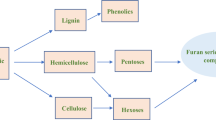Furfural derivatives prepared from vegetable raw materials have recently become popular as high-performance fuel additives. Furfural oxygenates are particularly of interest. A lot of research has been devoted to preparing new materials from furfural, however, there is much to be discovered about their effect on physicochemical properties of fuels. The possibility of using furfural derivatives, obtained by their hydrogenation on copper and nickel catalysts with full conversion of furfural, as additives to fuel is considered in this article. Their impact on antiknock properties and chemical stability is evaluated. It has been found that futons are mostly effective in low-octane hydrocarbon bases, such as hydrocracking gasoline, at a concentration of 5-30 wt. %. A high concentration of potential resins can lead to the formation of deposits in the combustion chamber of the engine, which, in turn, requires additional research.

Similar content being viewed by others
References
R. Mariscal, et al., Energy Environmental Science, 9,1144–1189 (2016).
J.P. Lange, et al, Chemistry and Sustainability Energy & Materials, 5, No. 1,150–166 (2012).
Ya. A. Masyutin, Synthesis and Study of Energy-Saturated Furan Compounds Based on Renewable Plant Materials [in Russian], dissertation, Moscow (2015).
E. Christensen, et al., Energy Fuels, 25, No. 10,4723–4733 (2011).
V. Tarabanko, et. Al., Russ. J. Appl. Chem., No. 88,1778–1782 (2015).
C. Wang, Fuel, 200–211 (2013).
S. V. Tarazanov, E. V. Grigor’eva, M. A. Titarenko, et al., Russ. J. Appl. Chem., 91, No. 12,1962–1967 (2018).
P. Panagiotopoulou, et al., J. Mol. Catal. A: Chem., 392,223–228 (2014).
I. L. Simakova, V. E. Tarabanko, M. Yu. Chernyak, et al., Journal of Siberian Federal University. Chemistry, 8, No. 4,482–492 (2015).
M. A. Ershov, E. V. Grigor'eva, A. I. Guseva, et al., Russ. I Appl. Chem., 90, No. 9,1402–1411 (2017).
S. Gouli, et al., Effects of Some Oxygenated Substitutes on Gasoline Properties, Spark Ignition Engine Performance, and Emissions, 12,918–924 (1998).
US Patent 2109159.
E. Christensen, Fuel, 212,576–585 (2018).
Applied research was carried out with the financial support of the Ministry of Education and Science of the Russian Federation in the framework of the Agreement on the provision of subsidies No. 14.576.21.0089 from September 26, 2017 (unique identifier RFMEFI57617X0089).
Author information
Authors and Affiliations
Corresponding author
Additional information
Translated from Khimiya i Tekhnologiya Topliv i Masel, No. 6, pp. 42 —45, November — December, 2019.
Rights and permissions
About this article
Cite this article
Nikul’shin, P.A., Ershov, M.A., Grigor’yeva, E.V. et al. Furfural Derivatives as Fuel Components. Chem Technol Fuels Oils 55, 720–725 (2020). https://doi.org/10.1007/s10553-020-01087-w
Published:
Issue Date:
DOI: https://doi.org/10.1007/s10553-020-01087-w



